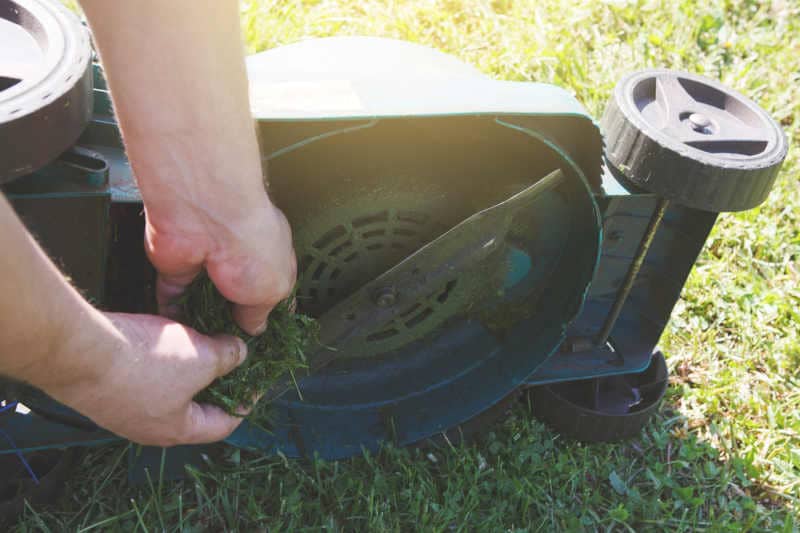Yes, they are! Most of them at least.
Lawnmower blades are heat treated, i.e., tempered. Tempering is the process of heating a blade to a so-called non-critical temperature to make the steel softer and less brittle and make the blade better at holding its edge, flexibility, and strength.
Lawnmower blades are heat-treated for a variety of reasons, including to become straighter, to be unsusceptible to wear and tear, etc.
The temperature of heating varies and usually depends on the type of metal or the choice of the manufacturer.

Below, learn more about the importance of lawnmower blades being heat-treated!
Quick Navigation
Why Are Lawnmower Blades Heat Treated & Tempered?
The heat treatment of blades is a process that’s commonly done with lawnmower blades, as well as tomahawks, axes, machetes, and knives.
Tempering requires the alloy or steel to be heated to a certain degree of temperature with the aim to lower the material’s hardness and brittleness.
The temperature of heating varies, but it must always be below the critical point, i.e., a thermodynamics term that refers to a melting point.
The heat treatment differs among manufacturers, but generally speaking, these are all standard practices of tempering. Most lawnmower blades are tempered to offer better quality and prolong their longevity.
Moreover, the heat treatment creates more strength in the blades and makes them more suitable for various terrains.
Thanks to the heat treatment, a lawnmower blade doesn’t snap easily and cuts grass terrains ideally. Tempered blades from reputable manufacturers won’t crack. Lawnmower blades made poorly will show it soon after you start using them.
Blades that crack easily (for example, from hitting a rock) may not have been tempered but were probably only hardened so their tensile strength is unable to withstand irregular terrains because it’s more brittle.
This is why it’s pivotal to invest in lawnmower blades that are tempered and made by trusted brands.
What Are the Benefits of Tempered Lawnmower Blades?
Tempering lawnmower blades is done to better the overall strength, longevity, and performance of the blade. Below, learn more about the advantages of tempering blades:
- The blades stay straight
Thanks to tempering, lawnmower blades remain straight, even when they’re going against rough terrains, pebbles, and rocks.
What’s more, tempering is done to lower the risk of the blades bending because this process changes the metal’s characteristics.
Namely, the heat causes the atoms to be tightly packed and thus, offers more longevity and strength.
- Equal hardness
Lawnmower blade hardness is pivotal.
Tempered lawnmower blades are potent and hardy and the equal distribution of strength is maximized.
Thanks to the equal distribution of strength, these blades are capable of lasting for a long period of time and withstanding tougher working conditions.
- Less prone to tear and wear
Tempered lawnmower blades are less prone to wear and tear. This is closely linked to the two aforementioned points; however, mowing conditions differ from one user to another.
The well-tempered blades tend to have a lower need of being sharpened frequently. Those that need it, are softer blades and the risk of them going blunt sooner is higher.
Heat treatment removes this softness and makes the blades less predisposed to tear and wear and ensures their longevity.
Quality lawnmower blades are the blades that have been tempered!
How Does Tempering Affect Lawnmower Blades?
Heat treatment of lawnmower blades isn’t a complicated process and if all the conditions are met, some people can even do it at home.
But, as metals have varying characteristics when they’re heated because of the arrangement of the atoms, there’s a need for metallurgy experts in the manufacturing of lawnmower blades for optimal results.
The first step of heat-treating metals involves hardening the blade. The product which is gotten after this process is known as martensite.
Afterward, the manufacturer decides if they need to harden the blades further or leave them as martensite. If they need further hardening, tempering is done to get all of the additional benefits that come with it.
However, since martensite is too hard and brittle to be practically used, its strength and ductility are recovered through the process of tempering.
This involves reheating the martensite to temperatures between 275- and 750-degrees F for a set number of hours.
Tempering vs. Hardening: Is There a Difference?
Tempered lawnmower blades tend to be hardened, but hardened blades aren’t necessarily tempered.
In order for blades to be tempered, they have to go through the process of hardening first. Martensite is the product that’s acquired after the hardening.
A manufacturer can stop at this part if it’s their standard. But they can also continue to the next step, i.e., the tempering if they need to.
For the tempering, the blade is cooled down in natural oil or water to temperatures lower than 390 degrees F. The temperature for hardening can go over 1300 degrees F, but this isn’t the case with tempering.
Hardened steel has a high level of brittleness and shouldn’t be used without toughening and thus, tempering becomes a necessity.
Tempering reduces this brittleness thanks to the lower temperature used that doesn’t go over 570 degrees F. It can be lower or higher and this depends on the manufacturer.
Tempering mustn’t be done excessively because it will cause the blades to go too soft, more than needed, and as a result, they’ll blunt faster.
When done properly, tempering creates a long-lasting, strong, and durable lawnmower blade.
Final Thoughts
Generally speaking, lawnmower blades are heat-treated and also tempered because this reduces their brittleness and makes them long-lasting, stronger, and less prone to wear and tear.
Why is this so important? -Tempering enables the blades to be used against harder and uneven terrains, which is a common occurrence when mowing lawns, without snapping easily.
Therefore, by choosing tempered lawnmower blades, you invest in a blade that will last for years to come and one that can maintain its power!